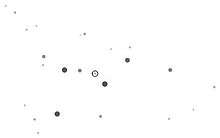Upsilon2 Cassiopeiae
- For other star systems with this Bayer designation, see Upsilon Cassiopeiae.
| Observation data Epoch J2000.0 Equinox J2000.0 | |
|---|---|
| Constellation | Cassiopeia |
| Right ascension | 00h 56m 39.905s[1] |
| Declination | +59° 10′ 51.80″[1] |
| Apparent magnitude (V) | +4.62 |
| Characteristics | |
| Spectral type | G8IIIbFe-0.5 |
| U−B color index | +0.69 |
| B−V color index | +0.96 |
| Variable type | none |
| Astrometry | |
| Radial velocity (Rv) | −47 km/s |
| Proper motion (μ) | RA: −92.65 ± 0.18[1] mas/yr Dec.: −45.50 ± 0.16[1] mas/yr |
| Parallax (π) | 16.32 ± 0.23[1] mas |
| Distance | 200 ± 3 ly (61.3 ± 0.9 pc) |
| Absolute magnitude (MV) | +0.62 |
| Other designations | |
Upsilon2 Cassiopeiae (υ2 Cas, υ2 Cassiopeiae) is a star in the constellation Cassiopeia. υ2 Cassiopeiae is a yellow G-type giant with an apparent magnitude of +4.62. It is approximately 200 light years from Earth.[1]

Map of the Bayer-designated stars in Cassiopeia. Upsilon2 Cassiopeiae is circled.
References
- 1 2 3 4 5 6 van Leeuwen, F. (2007). "Validation of the new Hipparcos reduction". Astronomy and Astrophysics. 474 (2): 653–664. arXiv:0708.1752
 . Bibcode:2007A&A...474..653V. doi:10.1051/0004-6361:20078357.Vizier catalog entry
. Bibcode:2007A&A...474..653V. doi:10.1051/0004-6361:20078357.Vizier catalog entry
This article is issued from Wikipedia - version of the 4/17/2016. The text is available under the Creative Commons Attribution/Share Alike but additional terms may apply for the media files.